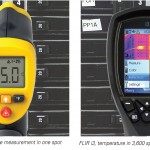Over the last 10 years there has been an explosion in the number of thermal imaging cameras available on the market and the prices have fallen faster. We now sit at a point in the market when an entry level thermal imager is available for less than £900 (€1,000, $1,200). This is very comparable with the price of a higher range spot temperature sensor and it’s worth comparing the two types of temperature measurement device to see what you get for your money.
The science behind both types of device is the same – they both use a micro-bolometer based sensor to detect incident infrared radiation and have pre-calibrated sensitivity that enables the conversion of this radiation to a temperature value, The measurement being the average over the area of each pixel. The accuracy of the measurement is dependent on the emissivity correction that is made by the user to compensate for the material properties of the target, and also on the “distance-to-spot ratio” or “instantaneous field of view” (iFoV), which describe the size of the thermal measurement area of one pixel at a known distance from the measurement device. This is often quoted as a ratio such as 200:1for a spot temperature sensor, or 3.7mRad for a thermal imager, and this value allows the user to calculate the maximum spot size for accurate measurement. The advantage of the mRad value is that it gives the spot size in mm at a distance of 1m ie: 3.7mm in this case, the ratio requires a small calculation – so for the ratio above, the spot size at 1m would be 5mm ).
The major difference between the two being that while the spot radiometer gives you a value from a single point, the thermal imager gives information about an area – 3600 spots in the case of the FLIR i3– the area being dependent on the number of pixels in the array. So when you look at the screen output from a spot radiometer, you are presented with a simple numerical value, and you hope you are measuring the hottest region, whereas when you look at the screen output from the thermal imager you
 will get a map of the temperature, allowing you to see whether you are at the hottest point, and if you use a FLIR Systems thermal imager such as the new i3, the spot marker will be scaled to the maximum spot size in the image.
will get a map of the temperature, allowing you to see whether you are at the hottest point, and if you use a FLIR Systems thermal imager such as the new i3, the spot marker will be scaled to the maximum spot size in the image.
So when you are in the field, scanning for a hot spot, the thermal imager gives a clear picture of the scene, whereas the spot radiometer is giving an average reading of the temperature of a single spot – as you go out to troubleshoot an electrical problem, or even a heat exchanger or HVAC problem, the multi-point heat map that is presented by the thermal imager will allow you scan the region of interest much faster, and give greater confidence that you have found the right problem, and found it much faster.
(This article was first published in Plant & Works Engineering, Iss 359, p18 (Jan/Feb 2012)
